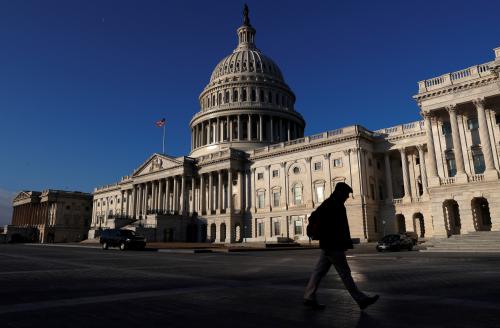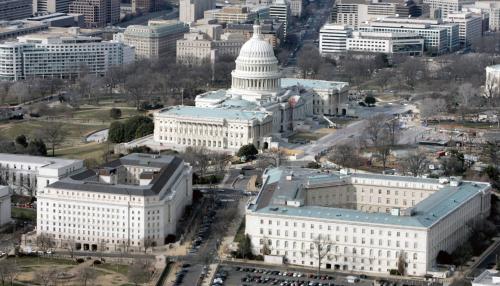On Tuesday, Representative Mick Mulvaney (R-SC) will appear before the Senate for his confirmation hearing to be director of the Office of Management and Budget. For Mulvaney, the transition from Congress to the executive branch will be a test case in the old lesson: “where you stand depends on where you sit.”
Much of Mulvaney’s reputation in Congress has been built on budget issues. After being elected as part of the Tea Party wave in 2010, Mulvaney was a vocal proponent of debt ceiling brinkmanship in 2011. In 2013, he led an effort to require that funding for Hurricane Sandy recovery efforts be offset by other spending cuts elsewhere. And in 2015, Mulvaney worked with then-Rep. Chris Van Hollen (D-MD) on efforts to curb the use of ‘emergency’ funds for defense and foreign operations.
The budgetary role of the OMB director, however, requires thinking on a different level than some of Mulvaney’s previous work in Congress. Among the director’s chief responsibilities is overseeing the preparation of president’s budget submission, making OMB, as a recent report from the White House Transition Project describes it,
“a place short of the president at which the desires of each agency are related to those of all the others, which compares those desires against the president’s overall plan, and which winnows down the thousands of issues thus revealed to the most essential ones that can finally be resolved only by the president.”
Or, put more succinctly by former Reagan administration OMB director James Miller: “it’s your job to worry about lots of things.”
For Mulvaney, considering these kinds of details and tradeoffs will involve something of a shift in perspective, from the general to the more specific. His previous experience contemplating budgetary details comes largely from his one term of service on the Budget Committee and his involvement in assembling the alternative budget proposal put forth by the conservative Republican Study Committee. While that work involves proposing specific spending changes, most of Mulvaney’s budget reputation has involved advancing his ideological priorities in a much blunter, less detail-oriented way. He has been a proponent of sequestration, a budgetary control technique that relies explicitly on inflicting pain everywhere rather than making specific tradeoffs. He was an original co-sponsor and vocal supporter of the 2011 ‘Cut, Cap, and Balance’ legislation that some House Republicans advocated as condition for approving an increase to the debt limit. Like the sequestration created by the 2011 Budget Control Act, the ‘cut’ and ‘cap’ pieces of the plan Mulvaney supported would have been similarly indiscriminate.
Not only will Mulvaney have to focus more heavily on the details of government spending, but he’ll also have to adjust to the fact that the politics of some budgetary issues are different depending on where one sits. For Mulvaney, this dynamic will present him with a notable challenge as early as March, when the current suspension of the debt limit expires. Mulvaney has a long history of doubting the consequences of not raising the debt ceiling. During the 2011 debate on the issue, he said that he “never believed the threat that this country will default on its debt as a result of any failure to raise the debt ceiling.” During the 2013 iteration of the conflict, Mulvaney claimed “we’re not going to default; there is no default.”
As political scientist Frances Lee has shown, for members of Congress, the politics of votes to raise the debt limit vary significantly depending on the relative power of her party. Historically, when a legislator’s party is situated as Republicans are today (that is, in the congressional majority and holding the White House), she and her co-partisans provide high levels of support for debt ceiling increases. Members of congressional parties situated as the Democrats are now (in the minority, with an opposite party president), meanwhile, generally do not vote in favor of raising the debt ceiling. During the Obama years, however, Lee documents one important change to this prevailing dynamic: members of the House minority party—the Democrats from 2011 to 2014—were more supportive of debt ceiling increases than their majority party counterparts. Republicans, she argues, had “political leverage to force the minority party to participate in governance so as to prevent embarrassment to the administration.”
Together, these two trends may present a real challenge for Mulvaney. While he may personally prefer not to raise the debt ceiling, his party may now be seen as responsible for the consequences of inaction in a way that were not during the Obama years. What’s more, history suggests they should not expect to be able to rely on votes from Democrats to approve a debt limit measure, especially since the minority party no longer has an incentive to protect the president.
If confirmed, Mulvaney’s work at OMB will involve not just budgetary tasks, but also important management responsibilities and regulatory oversight functions. It is budget issues, however, on which he has built a congressional reputation and that are the principal source of concern among his detractors. And indeed, his previous positions on the debt ceiling are troubling to anyone who cares about avoiding the serious consequences of default, and his support of the kind of fiscal brinkmanship that dominated the Obama administration should worry budget watchers who want to return to so-called “regular order.”









Commentary
Confirming Team Trump: At OMB, where Mulvaney stands may depend on where he sits
January 23, 2017